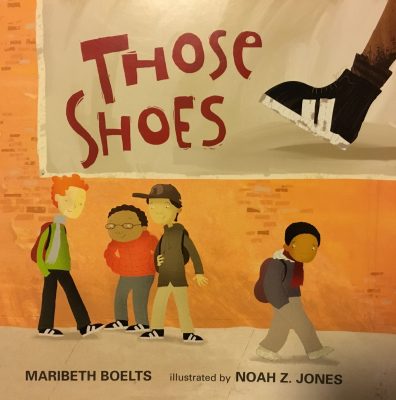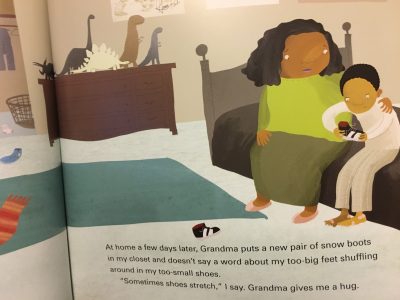- Title: Those Shoes
- Author(s): Maribeth Boelts
- Illustrator/Photographer: Noah Z. Jones
- Number of Pages: 35
- Publisher and Year: Candlewick Press, 2007
- Genre: Realistic Fiction
- Analysis: In Those Shoes, Jeremy wants a new pair of shoes, the ones that everyone is raving about. When Jeremy asks his grandma to buy him a pair, she tells him that they don’t have room for “want,” only “need.” In the end of the book, Jeremy realizes that things he has are more important than anything he could ever want.
Although Those Shoes is relatable for many young children, as a Black male speaking from personal experience, this story resonated with me heavily. I have seen and experienced Jeremy’s situation first-hand. As a child, for some reason, image is deemed as important; everybody wants to be cool or have that “cool” item. Often times, we get wrapped up in the idea of wanting material items in order to fit in. We get so consumed in wanting, that we take for granted the things we are fortunate to already have. Jeremy’s grandma is symbolic of the parents or caretakers who may not be able to get a child everything they want, but who make sure that their children are never in need. Those Shoes is a mirror for me simply because I see myself and so many others in Jeremy. However, for those who are not familiar with Jeremy’s situation, this is a window or door.
On the front cover of the book, “Those Shoes” are in big letters on a billboard, as well as a picture of the shoe. This billboard is above the characters, giving the impression that the shoes are bigger than the characters. In a circle, on the right, are three kids flaunting their new shoes, and on the left, is Jeremy, looking at the other children with his head hanging low. The cover shows Jeremy’s insecurity, contrasted with the other children’s confidence. I felt that the illustrations in Those Shoes did not add much to the text. For someone reading this story, they would not need the pictures to understand the story.
In conclusion, I feel that Those Shoes helps to teach children the value of intangible things. A loving family and good friendship are two things that Jeremy would not trade for the world. Although Jeremy did not get his shoes, he is appreciative that his grandma made sure he had warm snow boots, which was something Jeremy needed.


